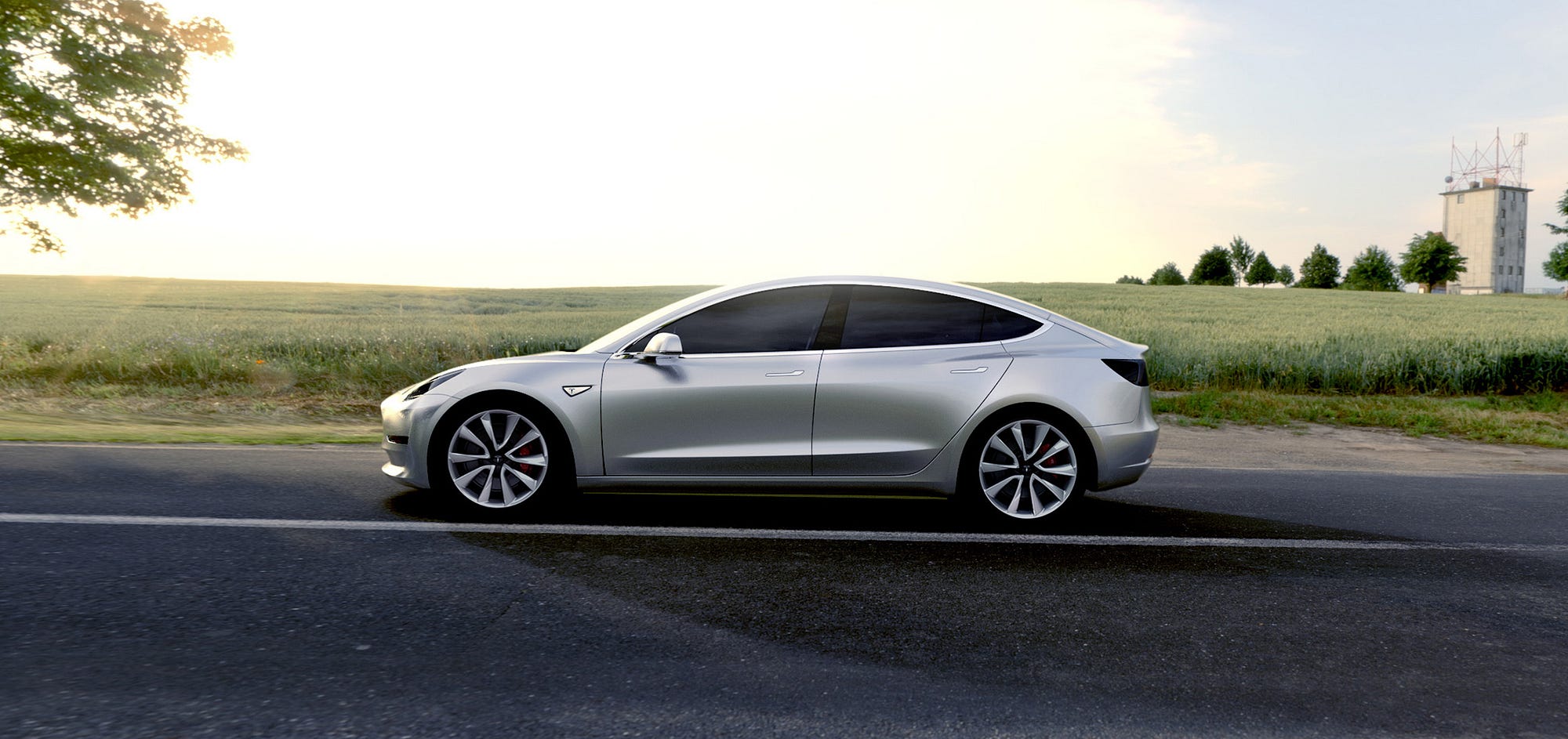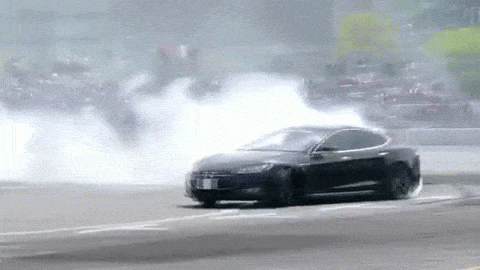The Model 3 and the Future of Cars — Medium

The Model 3 and the Future of Cars
Right after the Tesla Model 3 launch on March 31st, I had a few things to say on the subject. This post is an elaboration on the topic.
Tesla has the best strategic positioning of any car manufacturer currently operating. It’s easy to underestimate the company on the basis of its relatively small scale in the market: their goal is to produce 80–90k units this year out of a total US market of 17.5M cars sold. Even their 325k Model 3 pre-orders are just a drop in the bucket. But Tesla is several years ahead of all other manufacturers both technologically and operationally, and its competitors are fundamentally unable to respond. If you think about it, the competition has already had 10 years to counter Tesla’s moves, yet they haven’t. What’s going on?
The Technological Game Has Changed
The first issue existing manufacturers face is that the basis of competition in cars is changing — and not necessarily how you would immediately think. No, it’s not electric vs. gasoline drivetrain. It’s that software and computing is becoming a core part of the driving experience.
Most cars on the road these days are good enough for most people. By and large, they will get you and your family and cargo from point A to point B safely, efficiently, and comfortably. The industry has basically hit a plateau of mechanical innovation, and any incremental mechanical improvements are quickly copied and commoditized (e.g. side-impact airbags, double wishbone suspension, an extra 50 hp or 5 mpg). There’s very little anyone’s doing, mechanically, in the mass market, that’s actually unique.
While Tesla is excellent along all these technical measurements (insanely fast, insanely safe, insanely efficient), it did things that incumbents could not quickly copy because of the way it chose to build cars: with computing and software as a top priority.
Tesla is a technology company at heart and it shows. Tesla built over-the-air update functionality into the Model S from launch, and as a result you can now download an upgrade that adds the ability to summon your car to you. Meanwhile, when Ford’s MyFord Touch infotainment system was panned by consumers, customers could either install an upgrade to improve it via USB stick or have a dealer do it for them. Similarly, when Chrysler found out hackers could remotely disable a Jeep while it was driving, they had to issue a recall that required either a dealer visit or a similar USB-based update process. Tesla has been able to address some of its issues completely via over-the-air updates and is the only manufacturer that has publicly stated it is updating core engine control unit software over-the-air.
Incumbents commonly outsource components like anti-lock braking, electronic stability control, and power train systems to suppliers like Bosch and Delphi. Those systems all have significant compute components that major manufacturers chose not to develop in-house because their core competency was in vehicle design, assembly, and marketing, not in software design. Now the consequences of those outsourcing decisions are coming home to roost, and the result is a poor experience for car owners and an inability for manufacturers to quickly respond.

It takes years to design a car. The Tesla Roadster took 5 years from concept to small-scale production run, even with significant help from Lotus on parts and production. A new model on an existing platform and utilizing an existing powertrain takes 2–3 years to develop, but developing a new powertrain and chassis would greatly lengthen the time needed. Even if incumbents saw the success of the Model S when it launched in 2012 and decided it was the future of cars, there’s no guarantee they will have anything directly competitive (from a software perspective) on the road this year or next.
Cars are big, expensive, complicated, and highly regulated. Rebooting how you design a car is one thing. Rebooting your business model at the same time is a entirely different game.
A New Business Model
While Tesla faced massive challenges when it started work over a decade ago, it also had the opportunity to build a modern car company from the ground up. This meant not just designing a car from scratch, but also creating the best business model to sell that car.
Existing car companies are, for better or for worse, locked in to their business model. By law, they are not allowed to sell cars directly to consumers: dealers must act as intermediaries. But because of how the dealer franchise laws are written, the fact that Tesla didn’t already have dealerships allowed them to forgo creating them in the first place. [1]
This is important because electric cars don’t make much economic sense for dealers. Dealerships make the majority of their profit on financing and maintenance. Electric cars may still need financing, but they certainly don’t require anywhere near as much service as their gasoline-powered counterparts. There are far fewer moving parts, which means fewer parts that can wear out and fewer fluids that need regular replacing. Add to that the fact that Tesla can solve an increasing number of issues via over-the-air software updates, and the economic benefit of having physical dealerships erodes significantly.
Beyond economics, the lack of dealerships is a significant organizational advantage for Tesla. Manufacturers and dealerships have a somewhat adversarial relationship: manufacturers sell cars to dealerships, who then sell to end consumers, so dealers are the manufacturer’s immediate customer. This creates inefficiency: customers generally can’t order the exact car with the options they want; they either pick from what’s on the lot, or hunt around for the closest car to their ideal that’s available.
To paraphrase Steven Sinofsky, companies ship their org chart [2]. The existing problems with the car manufacturer business model and end product are a reflection of the fragmented interests of the manufacturer, its parts suppliers, and its dealership network. Currently, manufacturers need to satisfy dealers first and consumers second. The result is a market of largely mediocre products that leave consumers uninspired. But there may yet be a silver lining for manufacturers in an unlikely form: declining car ownership.
Renting to the Rescue
Ironically, the trend away from buying cars and towards ownership-as-a-service might be what saves incumbent car manufacturers. Several of them are already investing in alternative ownership models: Daimler owns Car2Go, a Zipcar competitor that offers one-way rentals within its cities; BMW recently launched ReachNow in Seattle, offering hourly rentals; and Audi launched an on-demand concierge rental service in the Bay Area. Transportation is a “job to be done,” and the smart money is betting that car ownership will shift to a service model going forward: Uber’s valuation is predicated on its ability to replace car ownership for a growing share of the population.
That doesn’t change the fact that software will be the crux of competition in the new world of transportation. Software is mostly shaping the experience of driving (and, increasingly, riding in) a car through functions like blind spot monitoring, lane assist, and, eventually, full autopilot. It will also be the means through which people manage their access to transportation, either through managing ownership (Drive, Beepi (et al.), Tesla) or access (Tesla Summon, Uber, Lyft, Zipcar).
Whether any manufacturers can develop enough direct consumer relationships to challenge Uber (or Google, or Apple) in the on-demand car space remains to be seen. While they certainly have enough resources to throw at the problem, those relationships are currently mediated through dealerships — a potential speed bump that Tesla wouldn’t have if (or when) it offers an on-demand product.
But it’s unclear how quickly that will matter: today it may be feasible to live primarily on Uber and Zipcar if you live in downtown San Francisco or New York, but it still doesn’t work as a full-time car replacement for most people in L.A. or even Menlo Park. While technology moves quickly, the built world is slow to change. Until we have more advanced and more widespread self-driving technology (and the regulations to support it), most Americans will continue to own their own cars. In the meantime, Tesla is better positioned than any other manufacturer to dominate consumer imagination — and demand.
[1] The New Yorker did a brief history on dealer franchise laws a decade ago. The takeaway is that in the 1920s and 30s, manufacturers strong-armed dealers into buying products they wouldn’t be able to sell. This led dealers to turn to state governments for protective laws to make up for their lack of leverage. Since most of these laws were written to regulate existing dealer-manufacturer relationships, Tesla often isn’t covered. As a result, in most states Tesla is allowed to sell directly to the public. But in some states, like Indiana, dealers are lobbying legislators to re-write the dealership laws to force all car manufacturers to sell through dealers, although this has received a lot of push-back from Tesla supporters. Other states like Texas, Michigan, Arizona, Connecticut, and West Virginia have pre-existing bans on direct sales.
[2] Sinofsky’s comment is itself a paraphrasing of Conway’s Law.
